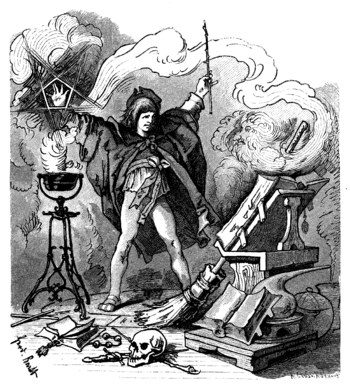The Sorcerer's Apprentice (Dukas)
The Sorcerer's Apprentice , the most famous work by the composer Paul Dukas , is the setting of the ballad of the same name by Johann Wolfgang von Goethe . This orchestral work , written in 1897 under the title L'Apprenti sorcier , belongs to the genre of program music . It is a musical adaptation of the story of the sorcerer's apprentice who unauthorized enchants a broom so that it fetches water for the master to fill a bath tub .
Music (related to the ballad)
The music begins with a tense atmosphere: the master is gone and the sorcerer's apprentice is torn between the idea of trying his hand at magic. Finally, he can no longer resist temptation. The first motif presented by the trumpet is the spell.

In response to the spell, a melody intoned by the bassoon rises : It is the broom that first practices a few steps before it sets off at an unstoppable speed armed with the buckets. The motif that characterizes the broom, which is melodically and rhythmically very memorable (the broom seems to bounce a little), is later picked up by other instruments and tirelessly pervades the whole piece. The pouring of the water into the tub is made audible by the rest of the orchestra , primarily by the string instruments , as is the swelling of the water in the room after the tub is filled.
In the middle of the piece - the water brought by the restlessly working broom is already distributed throughout the room - the motif of the sorcerer's apprentice can be heard again. However, it comes much shortened, because the sorcerer's apprentice has forgotten the spell and is now trying it in several keys , trying to stop the action. But after every wrong saying a new gush of water pours into the room. Thereupon the music reaches a climax, because in his desperation the sorcerer's apprentice throws himself with the ax on the broom and two crashing "blows" put an end to the hustle and bustle.
But after a short break, the contrabassoon sounds slowly with individual notes of the broom motif. It seems as if the split broom is struggling to get back on its feet. Soon the bass clarinet joins in and performs the same musical movement every decimal point . It is the second half of the broom that finds its own life. The motif of the broom sets in again, voiced by the three bassoons - the broom is on the move again. A few moments later, the same motif is played a fifth higher by the clarinets and the bass clarinet: the second broom! It seems as if this one only had to learn what task it was supposed to do and now does the same as the first one. So there are now two brooms that run tirelessly to bring more water. The music swells more and more to end abruptly at another climax; everything collapses. The master has come home and has ended the chaos. The sorcerer's apprentice is contrite, but his master leaves it to calmly presented admonitions (final passage before the four final chords).
Use in film
Dukas' setting of "Sorcerer's Apprentice" achieved a high degree of fame through the film " Fantasia " produced by Walt Disney in 1940 . Mickey Mouse plays the sorcerer's apprentice who fights brooms and water to Dukas' music.
occupation
1 piccolo , 2 large flutes , 2 oboes , 2 clarinets (B-flat), bass clarinet (B-flat), 3 bassoons , 1 double-bassoon - 4 horns (F), 2 trumpets (C), 2 cornets (B- flat ), 3 trombones - timpani , Glockenspiel (alternatively: Celesta ), triangle , Gr. Drum , cymbals - 1 harp - strings
Web links
- The Sorcerer's Apprentice : Sheet Music and Audio Files in the International Music Score Library Project